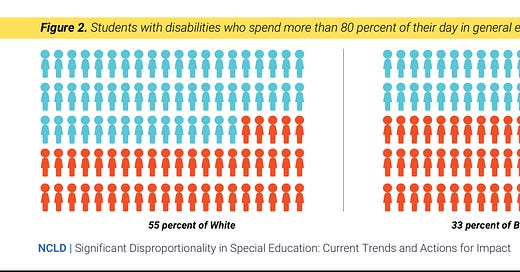Justices Limit the Use of Race in School Plans for Integration
My title comes from a 2007 New York Times article1 following the U.S. Supreme Court’s decision in a case against using race as a factor in maintaining diversity in public schools, specifically Seattle and Louisville. Color blindness decided the Court is the way forward. Brown v Board of Education pried open the doors of White schools in 1954. Race was the factor in perpetuating our separate but unequal public school system from its origin after the Civil War; race must be the factor in disrupting a system built for White people, so thought the Justices in 1954. Chief Justice John Roberts writing for the majority, who could only have believed that racism no longer exists in the 21st century, opined in a seductive tautology:
“The way to stop discrimination on the basis of race is to stop discrimination on the basis of race.”
Justice Ruth Bader Ginsburg during oral arguments raised the other side of the issue. With a well-developed understanding of oppression as an unfortunate feature in a country founded on the three-fifths clause, Ginsburg described a difference in vision, a difference in ways of seeing reality, that woke no sleeping Anthony Kennedy, the swing vote.
“It’s very hard for me to see how you can have a racial objective but a nonracial means to get there.”
History was clearly writ large on the walls of the Supreme Court during their deliberations, but ways of reading it sharply differed. Foreshadowing the liberal dystopia critical theorists are surfacing in ethnographies today2, Justice Clarence Thomas added a fine point to the argument with his counter to the counter:
“If history has taught us anything, it has taught us to beware of elites bearing racist theories. Justice Breyer’s good intentions, which I do not doubt, have the shelf life of Justice Breyer’s tenure.”
Look away, Thomas said. Don’t expect those who visited injustice on you to help you out. Justice Thomas’s caution as I read it hinges on one word: ‘elites.’ I see the word White in elite. I wonder if Thomas would caution us to beware of elites bringing special education? This legal decision in 2007 to constrain public schools from taking race-conscious action to sustain diversity frees schools to continue making enrollment decisions seemingly based on race in special education.
Low-income students, disproportionately Black and Brown, are more often identified in subjective disability categories like emotional or intellectual disability and more frequently removed from regular classrooms than White students. They are more often placed in classrooms where academic outcomes are worse and expectations for success are lower. Their teachers have less expertise in math, English, and science.
That Black students end up in special education with a diagnosis of specific learning disability (but not dyslexia) is well documented. The following figure was published in by the National Center for Learning Disabilities (2020) an online flyer3:
For the past several decades, scientists in a variety of fields have collaborated to examine relationships between brain activity and reading. Experiences in early childhood have a profound impact as the brain wires itself for its upcoming life; brain plasticity explains how children learn language regardless of culture of birth. Language itself uses massive brain territory and circuits.
Beyond a shadow of a doubt, small numbers of readers who struggle with decoding of any orthography and script rely on otherwise insignificant neural pathways in the brain in ways that differ from others who learn relatively easily. Yet the U.S. and other countries spell out in law that special resources dedicated to reading instruction for dyslexics can be applied only after what amounts to a medical diagnosis. The need for fervent scientism in this regard is under dispute in the research. Note well: Learners from economically disadvantaged lives are legally disqualified from a dyslexia diagnosis. The cause of reading failure among the poor is not a disability, but deprivation. Therefore, sans disability, sans special teaching. That doesn’t mean the poor get to stay in the regular classroom if they act up.
Since the early 2000s scientists have examined the general relationship between socioeconomic status and brain development. Rakesh and Whittle (2021)4 published a meta analysis of 61 studies using SES as an independent variable and brain volume and size as a dependent variable. Here is a portion of the abstract of the paper:
“A growing literature has shown associations between socioeconomic disadvantage and neural properties (such as brain structure and function). In this review, we aimed to synthesize findings on the neural correlates of socioeconomic status (SES) in youth samples across neuroimaging modalities. We also aimed to disentangle the effects of different SES measures (e.g., parent income and education) in our synthesis. We found relatively consistent patterns of positive associations between SES and both volume and cortical surface area of frontal regions, and amygdala, hippocampal, and striatal volume (with most consistent results for composite SES indices). Despite limited longitudinal work, results suggest that SES is associated with developmental trajectories of gray matter structure.”
Beware of elites bearing racist theories?
Justices Limit the Use of Race in School Plans for Integration
By Linda Greenhouse NY Times June 29, 2007
https://www.dukeupress.edu/progressive-dystopia
NCLD | Significant Disproportionality in Special Education: Current Trends and Actions for Impact
For more information, visit www.ncld.org or contact NCLD via email: info@ncld.org
1220 L Street, NW Ste. 100 Box #168 Washington, DC 20005
© 2020 National Center for Learning Disabilities
Rakesh and Whittier (2021)
https://www.sciencedirect.com/science/article/abs/pii/S0149763421003778



